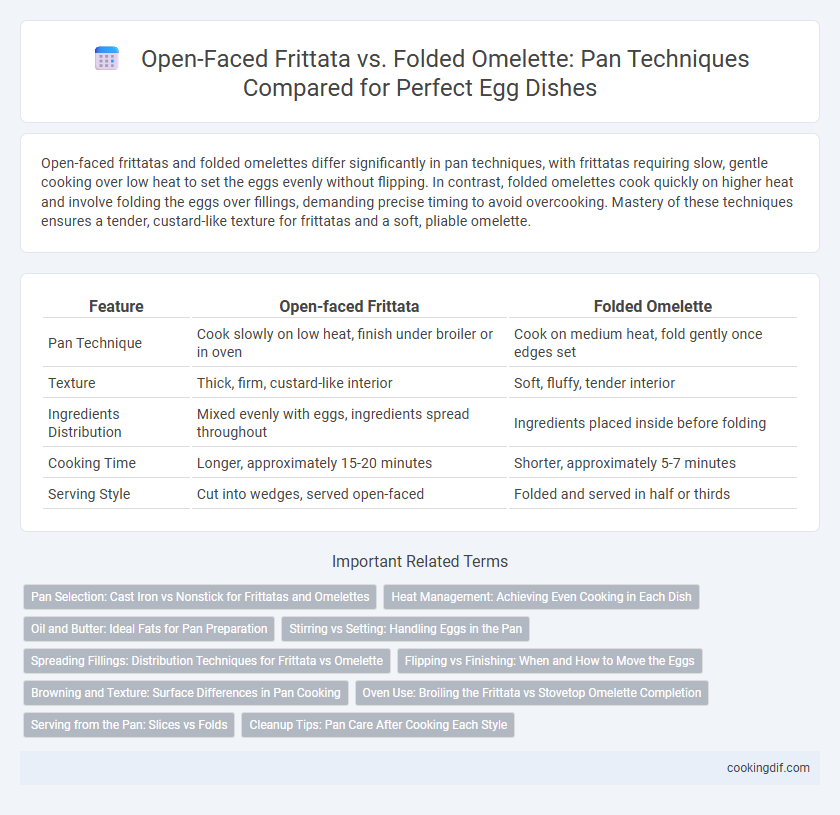Open-faced frittatas and folded omelettes differ significantly in pan techniques, with frittatas requiring slow, gentle cooking over low heat to set the eggs evenly without flipping. In contrast, folded omelettes cook quickly on higher heat and involve folding the eggs over fillings, demanding precise timing to avoid overcooking. Mastery of these techniques ensures a tender, custard-like texture for frittatas and a soft, pliable omelette.
Table of Comparison
| Feature | Open-faced Frittata | Folded Omelette |
|---|---|---|
| Pan Technique | Cook slowly on low heat, finish under broiler or in oven | Cook on medium heat, fold gently once edges set |
| Texture | Thick, firm, custard-like interior | Soft, fluffy, tender interior |
| Ingredients Distribution | Mixed evenly with eggs, ingredients spread throughout | Ingredients placed inside before folding |
| Cooking Time | Longer, approximately 15-20 minutes | Shorter, approximately 5-7 minutes |
| Serving Style | Cut into wedges, served open-faced | Folded and served in half or thirds |
Pan Selection: Cast Iron vs Nonstick for Frittatas and Omelettes
Cast iron pans retain heat evenly, making them ideal for open-faced frittatas that require consistent browning and oven finishing. Nonstick pans provide easy release, perfect for folded omelettes needing gentle flipping and soft texture. Choosing the right pan enhances cooking technique: cast iron sharpens frittata crust and structure, while nonstick preserves delicate omelette folds.
Heat Management: Achieving Even Cooking in Each Dish
Open-faced frittatas require moderate, consistent heat to ensure the egg mixture cooks evenly from the edges to the center without burning the bottom, often finished under a broiler to set the top. Folded omelettes demand higher heat for a shorter time, allowing quick cooking that seals the exterior while keeping the interior soft and creamy. Precise heat control in both techniques prevents overcooking and produces optimal texture, with frittatas favoring gradual heat diffusion and omelettes relying on rapid, even heat application.
Oil and Butter: Ideal Fats for Pan Preparation
Open-faced frittatas require a generous amount of oil or butter to create a non-stick surface for even cooking and easy slicing, with olive oil and clarified butter being top choices due to their high smoke points and rich flavors. Folded omelettes benefit from a light coating of butter, which adds a creamy texture and helps achieve a delicate, golden-brown exterior without overwhelming the eggs. Using the right fat not only prevents sticking but also enhances taste and texture, making the pan preparation crucial for both techniques.
Stirring vs Setting: Handling Eggs in the Pan
An open-faced frittata requires gentle stirring initially to distribute ingredients evenly before allowing the eggs to set slowly over low heat, creating a tender, custard-like texture. In contrast, a folded omelette involves minimal stirring, focusing on rapid setting of eggs with higher heat to achieve a firm yet pliable exterior suitable for folding. Mastering the balance between stirring and setting is essential for optimal texture, with frittatas favoring gradual setting and omelettes emphasizing swift cooking and quick folding techniques.
Spreading Fillings: Distribution Techniques for Frittata vs Omelette
Open-faced frittatas require evenly spreading fillings across the entire surface to ensure consistent cooking and balanced flavor in every bite, often using a spatula to gently distribute ingredients. Folded omelettes concentrate fillings in the center, allowing the edges to cook through singly, resulting in a pocket of concentrated flavors when folded. Mastering these distinct distribution techniques optimizes texture and taste unique to each pan-cooked egg dish.
Flipping vs Finishing: When and How to Move the Eggs
Open-faced frittatas require careful timing for flipping, often cooked slowly on low heat to set the eggs before finishing under a broiler or in the oven to achieve even cooking without flipping. Folded omelettes demand quicker, attentive flipping techniques to fold the eggs gently once the base firms up, preserving the creamy interior texture. Mastering these methods ensures optimal texture and doneness, with frittatas benefiting from restrained movement and omelettes requiring precise, swift flipping.
Browning and Texture: Surface Differences in Pan Cooking
Open-faced frittatas develop a golden-brown, slightly crispy surface due to direct heat exposure, enhancing flavor complexity and a firm texture. Folded omelettes maintain a softer, more tender exterior with limited browning, preserving a delicate interior moisture balance. Pan techniques differ as frittatas require even heat distribution and occasional oven finishing, while omelettes rely on swift cooking and gentle folding to retain fluffiness.
Oven Use: Broiling the Frittata vs Stovetop Omelette Completion
Open-faced frittatas benefit from oven broiling, which ensures even cooking and a perfectly set top with a golden finish, while folded omelettes require stovetop techniques to carefully cook through without burning. Broiling in the oven allows the frittata to cook uniformly from both the bottom and top, eliminating the need to flip or fold and creating a creamy texture. In contrast, the folded omelette relies on controlled heat and timing over the stovetop to achieve a tender interior without overcooking the exterior.
Serving from the Pan: Slices vs Folds
Open-faced frittatas serve directly from the pan in slices, preserving the dish's thick, layered texture and allowing even portions with visible ingredients. Folded omelettes are served by sliding or folding the cooked egg over fillings, creating a compact, layered presentation ideal for individual servings. The slice method highlights a more rustic, shareable style, while folds emphasize portability and distinct portion sizes.
Cleanup Tips: Pan Care After Cooking Each Style
Open-faced frittatas typically require careful pan cleaning due to the baked-on cheese and egg layers, best managed by soaking in warm, soapy water immediately after cooking to loosen residues. Folded omelettes, cooked quickly on medium heat, often leave less stubborn food particles, allowing for simpler cleaning with a gentle scrub using a non-abrasive sponge. Using non-stick pans and avoiding high heat can preserve pan surfaces and reduce the effort needed for cleanup after preparing both frittatas and omelettes.
Open-faced Frittata vs Folded Omelette for pan techniques Infographic

 cookingdif.com
cookingdif.com